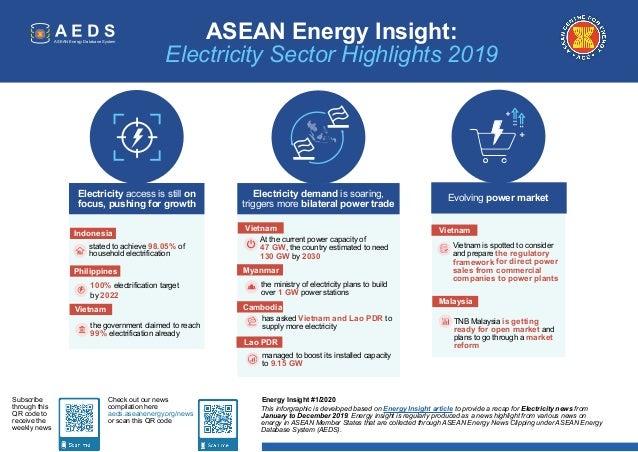
ASEAN Electricity Sector: 2019 Highlights
Nadhilah Shani, Research Analyst
Last year in 2019, ACE has successfully collected 2,410 energy news from various media, providing our loyal subscriber weekly update on what is happening in the region. Observing the archive, there are three sectors which were most reported throughout the year: Solar, Electricity, and Electric Vehicle.
In this insight, let us give you glance of the full story from ASEAN electricity sector by picking the worth to be highlighted news throughout the year. Electricity access is still on focus, pushing for growth.
Fighting the rights for its citizen to get electricity access is one among the energy focus of ASEAN countries. Good news came from Indonesia where the government stated to achieve 98.05% of household electrification. Data showed that in the last eight years Indonesia has successfully jumped the electrification ratio from only 67.2 in 2010 to 98.05 % in the end of 2018. Indonesian government aims to finish the work to the last mile in electrifying the household to be 100% in 2020.
Similar spirit was carried in Philippines under the administration of Energy Secretary Alfonso G. Cusi which aiming 100% electrification target by 2022. National Electrification Administration (NEA) together with Energy Commission who carried out the rural electrification program, 12.8 million household connections were reached in the ned of January 2019.
While in Vietnam, the government claimed to reach 99% electrification already and able to provide relatively low cost electricity compared to the neighbouring country. Hence, the country will move forward in attracting more investment and enhancing efficiency of power production as the next focus

Asean electricity sector 1 2020 from ASEAN Centre for Energy
Electricity demand is soaring, triggers more bilateral power trade
Fuelling the economy, electricity demand continues to soar in ASEAN countries. Vietnam electricity demand rises faster than its GDP growth. At the current power capacity of 47 GW, the country estimated to need 130 GW by 2030, a huge gap to catch for the power investment and infrastructure. This creates a concern of the possible power shortage in the next few years, noting the demand rises faster than the supply.
Myanmar power sector is also in pressure to provide enough power supply for its people. As an effort to fulfil this, the ministry of electricity plans to build over 1 GW power stations within one and half year.
In the other side, Cambodia’s electricity sector is suffering due to climate-change impact of the prolonged drought. Regular power outage and shortage happened due to decreasing supply of hydropower sources, which leads to imports from the neighbours. Cambodia has asked Vietnam and Lao PDR to supply more electricity. Lao PDR as ‘the battery’ of the ASEAN mainland, also managed to boost its installed capacity to 9.15 GW as 12 new power plants kickstarts commercial operations.
Evolving power market
From the business perspectives, 2019 is also about opening new opportunities and market structure in ASEAN electricity market. Vietnam is spotted to consider and prepare the regulatory framework for direct power sales from commercial companies to power plants. This pilot implementation is established to lay the foundation for competitive retail electricity market in 2021. Running towards this, the ministry needs to resolve several issues that emerge such as ensuring safe and stable power operation.
While TNB Malaysia is getting ready for open market and plans to go through a market reform. This plan was initiated by the first step of restructuring current Tenaga National Bhd as state-owned utility to separate its retail and generation as two subsidiaries.
If you wish to follow ASEAN journey in the energy sector, please subscribe through this link, so we can extend our energy insights & weekly news clippings to you.
Source :https://aseanenergy.org/asean-electricity-sector-2019-highlights-2/









0 nhận xét:
Đăng nhận xét